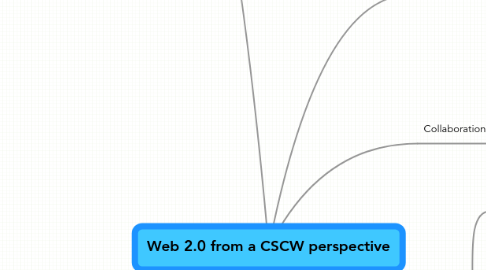
1. Unstructured article input
1.1. Blogging as Social Activity, or, Would You Let 900 Million People Read Your Diary?
1.1.1. http://doi.acm.org/10.1145/1031607.1031643
1.1.2. Study of personal blogs
1.1.3. Blog content taxonomy
1.1.3.1. personal journal (70% of all)
1.1.3.2. "filters" (commentaries, select from other blogs/news)
1.1.3.3. knowledge logs
1.1.4. Blog is social activity
1.1.4.1. Mostly for close social network
1.1.4.2. To get attention from unknown
1.1.5. Blog is object oriented
1.1.5.1. Updating others on activities
1.1.5.2. Expression opinions to influence
1.1.5.3. Seeking opinions from others
1.1.5.4. "Thinking by writing"
1.1.5.5. Release of emotional tension
1.1.6. Want readers, but not interact with them
1.1.7. Group/collaborative blogging should make individual stand out
1.2. A Face(book) in the Crowd: Social Searching vs. Social Browsing
1.2.1. http://doi.acm.org/10.1145/1180875.1180901
1.2.2. Meeting first online or offline
1.2.3. Old article(?) facebook builds networks on offline relations?
1.2.4. More affectionate relationships
1.2.4.1. .. or looser informal ties.
1.2.5. "Surveillance" features of facebook
1.2.5.1. Track community members
1.2.5.2. Privacy issues
1.2.6. Network based of "peers"
1.2.6.1. Not staff or lecturers (hierachy)
1.3. What Goes Around Comes Around: An analysis of del.icio.us as social space
1.3.1. http://doi.acm.org/10.1145/1180875.1180905
1.3.2. Focus on social "awareness"
1.3.3. And how it affects participation in adding to community "pool"
1.3.4. Physical presence affects, how is social perception in del.icio.us
1.3.5. "Friends" are perceived as social precense
1.3.6. And social awareness gives more participation
1.4. The Long Tail
1.4.1. Think probalistic
1.4.2. Big numbers, single "tags" not perfect, but majority is correct
1.4.3. http://www.wired.com/wired/archive/12.10/tail.html
1.4.4. (no cscw focus, general about "long tail" catalogs for internet business)
1.5. ECSCW 2007 papers
1.5.1. Towards a CROSS FERTILIZATION Between Social Software and CSCW
1.5.1.1. http://kortlink.dk/tu-muenchen/53zf
1.5.2. I know what you did last summer: What can we learn from photolog?
1.5.2.1. http://kortlink.dk/tu-muenchen/53zh
1.5.2.2. Another tagging system (photos)
1.5.2.3. Success factors
1.5.2.3.1. Digital cameras easily available (easy)
1.5.2.3.2. Synergies with blogs
1.5.2.3.3. Technology easy to use (eh?)
1.5.2.3.4. Many people spend much time online
1.5.2.3.5. "Connect" and socialize over photos sharing
1.5.2.3.6. Its photos :-)
1.5.2.4. Collaboratinon and communities
1.5.2.5. Gives power to users (they "control" their data)
1.5.2.6. Photolurkers, some are not contributing, but part of their own social network
1.5.3. “Channeling”: Applying Social Software Design Principles to CSCW Scenarios
1.5.3.1. http://kortlink.dk/tu-muenchen/53ze
1.6. HT06, Tagging Paper, Taxonomy, Flickr, Academic Article, To Read
1.6.1. Simple model
1.6.1.1. Users
1.6.1.2. Resources
1.6.1.3. Tags
1.6.2. http://doi.acm.org/10.1145/1149941.1149949
1.7. Shared Waypoints and Social Tagging to Support Collaboration in Software Development
1.7.1. http://doi.acm.org/10.1145/1180875.1180906
1.8. What is Web2.0?
1.8.1. http://kortlink.dk/oreillynet/53zm
1.8.2. (not enough focus on cscw)
1.8.3. Defines Web2.0 but mostly from a technical POV
1.8.4. Does talk about
1.8.4.1. Recommender systems
1.8.4.2. Collaborative filtering
1.8.4.3. Coorperate dont control
1.8.4.4. The Perpetual Beta
1.8.4.5. Network platform
1.8.4.6. Gather data "en mas" for collective intelligence
2. Summary
2.1. Web2.0
2.1.1. Create new ways to communicate (+tools) for public
2.1.2. New technologies
2.1.3. Focus on usefulness and freedom
2.2. CSCW
2.2.1. Collaboration in enterprise, focus on organization
2.2.2. Insight in groups and structures
3. From the book, communities are ..
3.1. "a set of people who share something"
3.1.1. Language
3.1.2. Network access
3.1.3. All citizens of Esbjerg
3.1.4. CSCW students
3.1.5. Non-danish speaking students/professors
3.2. Related to teams in groupwork like ...
3.2.1. Members do not need to know eachother personally
3.2.2. Do not need to interact on a personal basis
3.2.3. Direct interaction is accidental, no group process
3.2.4. No group process
3.2.5. No common goal or task (loose interaction)
3.2.6. No shared artifacts/documents
3.2.7. Personal interests over community interests
4. What is Web2.0?
4.1. Social Software
4.2. Communities vs. Collaboration
4.3. Examples of places; youtube, del.icio.us, facebook
4.3.1. "Social" vs. "work"
4.3.2. Show different CSCW concepts
4.4. Taxonomies (?)
4.4.1. Related to CSCW taxonomies (?)
5. Collaboration perspective
5.1. Web2.0
5.1.1. Fast, easy, open, quick rewards
5.1.2. Focus on needs of single user, shared benefits by quantity/stats/"accident"
5.1.3. Network and communities
5.1.4. Network effect - system gets better the more people using
5.1.4.1. Statistical "better", large numbers
5.2. CSCW
5.2.1. Collaboration, group, group process, structure, hieracies, shared workspaces
5.2.2. Made for groups and teams with common goal
5.2.3. No network effect, less data but better structure?
5.3. General principles
5.3.1. Users should draw atleast same value as effort invested in system
6. Differences
6.1. Where to use
6.1.1. Web2.0: Only in public use
6.1.1.1. Loose integration with organisational context
6.1.1.2. Complex group structures not supported good
6.1.2. CSCW: Mostly in enterprise (?)
6.2. Example: Facebook vs Sharepoint
6.2.1. Facebook: Could be used for something serious
6.2.2. Sharepoint: Hard to use for something fun
6.3. System introduction
6.3.1. Web2.0
6.3.1.1. "Beta" products, focus on technology
6.3.2. CSCW
6.3.2.1. Introduction of systems, problem solving
6.4. Development model
6.4.1. Web2.0: Bottom-up, users are part of evolution
6.4.2. CSCW: Top-down, solve problems for groups
